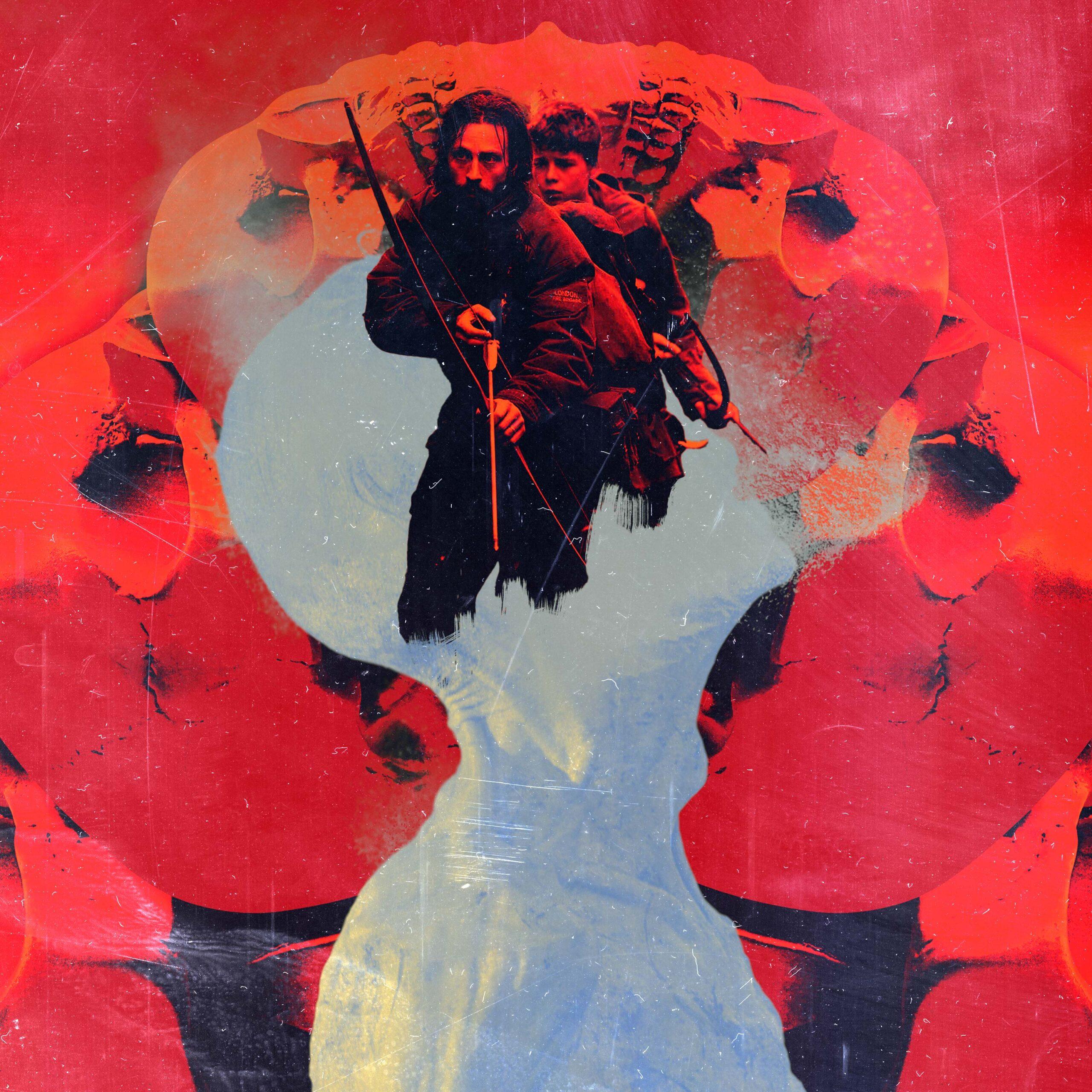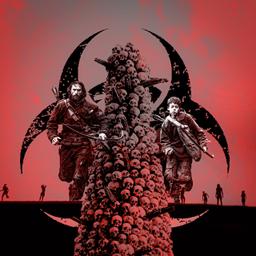
“There’s no discharge in the war,” observes the narrator of Rudyard Kipling’s 1915 poem “Boots,” about the drudgery and the terror of a life spent in the trenches. There’s also no place to charge your iPhone. Stranded in a field in England—more specifically Northumberland, which, like the rest of the British Isles, has been infested with scores of bloodthirsty living dead since the turn of the 21st century—a foreign soldier looks contemptuously at his cellphone, which is down to 1 percent battery. “It’ll be a brick in a minute,” he scoffs to his companions before tossing the thing into the tall grass. Given the postapocalyptic particulars of their situation, it’s not like he can call for backup anyway.
Danny Boyle’s long-awaited 28 Years Later is, on some level, an Extremely Goofy Movie, but it contains multitudes: It’s literary enough to invoke Kipling (and Taylor Holmes’s chilling, rhythmic spoken-word rendition) in a way that matters and also knowing enough to deploy the aforementioned bit of Apple product placement as a self-reflexive sight gag. Way back in 2002, Boyle and his cinematographer Anthony Dod Mantle—a master of raw, unvarnished textures known for his work with Lars von Trier—shot the original 28 Days Later on consumer-grade camcorders, meeting the post–Blair Witch Project demand for found-footage realism with an immersion in digital murk. Reuniting two decades later for the sequel, Boyle and Mantle have opted to use the iPhone 15 Max—or actually a whole fleet of them, yoked to a laser-printed 3D rig—a choice that drags their aesthetic in the opposite direction, away from punkish ugliness toward an anodyne and scarifying clarity. (“He said the word ‘smartphone’ and I looked at him kind of like Beavis and Butt-Head,” Mantle told The Film Stage.)
Boyle has always been a showman who likes to induce hallucinations in his viewers. Sometimes he comes off as a genuine necromancer, conjuring up dark, kinetic magic, as in Trainspotting, Sunshine, and 28 Days Later; elsewhere, he lapses into gearhead dogma (the boring format fetishism of Steve Jobs), sentimental kitsch (the phony Beatlemania of Yesterday), or banal crowd-pleasing (e.g., Slumdog Millionaire, a movie so pushy and ingratiating that it won Best Picture). Such shape-shifting inconsistency can be maddening (or a sign of high-end hackery), but it also means that there’s still a certain element of surprise decades into his career. So it’s heartening to report that 28 Years Later—goofy, yes, but also lucid and non-superfluous by legacy sequel standards—is his best movie in a long time, surpassing the better than expected T2 Trainspotting as a victory lap around home turf. The excitement begins with its frenetic but sophisticated visual scheme, which pivots on a stunningly realized sense of scale. “We wanted to plop the characters amid this enormous expanse of nature,” Mantle explained in an interview with The Credits. The compositions smartly exploit exterior locations for negative space; the overwhelming feeling is that of being somehow stranded and encircled all at once. The sheer hugeness of certain images is arresting, as the extra-wide aspect ratio pushes certain sequences—a glimpse of distant fire along an endless tree line, a group of naked infected cresting a hill in silhouette, a vertiginous drone’s-eye view of a father and son being pursued at dusk along a waterlogged causeway—into the realm of authentically cosmic horror.
It’s not just Boyle and Mantle who are in good form here. Alex Garland’s script is probably the best of his career, filtering his pet concerns—the fragility of social codes, the ambiguity of human nature, how cool it is to watch phalanxes of heavily armed soldiers securing various perimeters—through a surprisingly multifaceted series of emotional prisms. All zombie movies are to some extent about mortality—it’s the most melancholy horror subgenre and also the most hopeless, predicated on processes of decay and contagion—but 28 Years Later is death tinged in ways that bypass convention. The most devastating moment in 28 Days Later was Brendan Gleeson’s last desperate look at his daughter before succumbing to the rage virus, and, without defaulting on his obligation to deliver the gory genre goods, which there are plenty of, Garland exposes and touches a similar set of nerves. The tension between the film's outsized presentation and its intimate dramaturgy is real and bracing; it’s an epic that grows increasingly overwhelming as it shrinks its field of view.
Beginning with his 1996 debut novel, The Beach (the film adaptation of which also initiated his long-running collaboration with Boyle), Garland has displayed a fascination with—bordering a pathological reliance on—stories of isolated enclaves teetering on the edge of some larger, darker reality. And so it is in 28 Years Later, which is set primarily in Lindisfarne, a.k.a. Holy Island, a rocky outcropping in the North Sea connected to the mainland via a land bridge whose accessibility comes and goes with the tides. As a naturally occurring metaphor for post-Brexit isolationism, Lindisfarne and its long, lonely road in and out of town do nicely. Boyle and Garland sharpen the political implications by depicting the population as staunch, time-warped survivors who fetishize their distance from the rest of the world, donning metallic masks, rallying around the flag, and getting righteously pissed down at their local. (Meat is in short supply here, but beer flows freely.)
Beyond the naturally occurring barrier of the causeway, the island is heavily fortified against potential invasion. There are also systems in place to ensure that the population stays in fighting shape. The primary rite of passage is for boys to go on supervised hunting expeditions to the mainland, honing their bow and arrow skills (and, it’s implied, cultivating a greater appreciation for the tough but secure life they’re living behind iron gates). “The more you kill, the easier it gets,” says roughneck Jamie (Aaron Taylor-Johnson) to his son, Spike (Alfie Williams), who’s reluctant to make the journey, less out of fear for his own safety than over leaving his mother, Isla (Jodie Comer), as she languishes in the throes of some mysterious illness. Alfie suspects that his dad is sick of carrying such a heavy load and doubts his own abilities to help shoulder it; he also finds killing difficult, practically speaking, even when the targets are the lumbering, corpulent, “slow and low” zombies who constitute one evolutionary development in Garland’s rage virus–infected universe. The other new infected variant is the alphas, behemoths who preside over their feral, roving packs and may or may not be operating with more intelligence behind their bloodshot eyes.
The first section of 28 Years Later is basically an extended stalk-and-chase sequence with Jamie and Alfie trying to make it out of their male-bonding ritual alive. (Another line from Kipling: “If you let your eyes drop, they’ll get atop o’ you.”) This stuff is all perfectly absorbing and suspenseful, if slightly familiar—an accomplished scare machine hitting its marks at top speed. Where things start to get interesting is upon the return to the island, which Alfie is indeed seeing through new eyes. Instead of being radicalized to defend his community, he sees himself as a protector for his mom and decides that the only way to help her—instead of just waiting around for her to die—is to sneak back to the mainland in search of a doctor, Kelson, whose reputation as a lone nut proves an irresistible lure. Where the father-son passages are tense and pressurized like they’re from a thriller, Alfie’s second foray into the forest is more uncanny, like a fairy tale or a vision quest.
That sense of weirdness carries through Garland’s obligatory detour into paramilitary iconography and also when the infected reappear and start displaying behavior that’s not only unprecedented for the series but also smartly connected to the underlying motif of family bonds and the means by which they become strengthened and severed under duress. There’s at least one set piece aboard an abandoned, stationary train that’s so outrageous—in both concept and execution—that it threatens to send the movie off the rails (not that there’s anything wrong with that). More horror movies could stand to take risks like this, and it’s thrilling to watch filmmakers throwing caution to the wind without losing their nerve. The actors also rise to the occasion: Williams, who was 13 when the film was shot, is suitably furtive and sad, and he has excellent scene partners in Taylor-Johnson and Comer, each of whom claws out from under their respective parental archetypes. Meanwhile, the less said about Ralph Fiennes’s late-in-the-game appearance the better, but it’s a role that makes use of his most underrated quality—the ability to inhabit a halting, controlled sort of tenderness—while bumping up against some phenomenally morbid comedy.
It’s during Fiennes’s screen time that 28 Years Later arrives at and scales its expressionist peak: a sequence whose stark, graphic power is bound up in its pulpiness, like a video game cutscene designed by Hieronymus Bosch. What makes the tableau work—propelling the film past the ridiculous and toward the sublime—is how it somehow builds up and strips away subtext at the same time: It’s hard to take because it’s easy to understand, and vice versa. Considering that Garland sometimes stumbles when he tries to extract real feelings from his B-movie conceits—and that Boyle is at his worst when he goes in for the directorial equivalent of a bear hug—the legitimately shivery metaphysics on display feel almost miraculous. It’s interesting to juxtapose the film’s humane, poetic invocation of “memento mori” with the button-pushing tactics of Mike Flanagan’s The Life of Chuck, made by a horror director seeking prestige status; 28 Years Later, by contrast, accrues gravitas precisely because it doesn’t waste time chasing after respectability.
On that note, there’s going to be plenty said about the movie’s coda, which cops to Boyle’s franchise-meister ambitions (a sequel, titled 28 Years Later: The Bone Temple, was shot back-to-back and is currently in postproduction) and arguably ends up undermining all the rich, ambivalent emotions brought forth before it. It is, as I implied earlier, extremely goofy, yet the more I’ve thought about it since walking out of the theater, the more I feel inclined to give the filmmakers the benefit of the doubt. They’re playing the long game, which means that it’s also their prerogative to rewrite the rules (in spray paint, as it turns out) as they go along. The prevailing theme of 28 Days Later was always about our collective and bloodthirsty appetite for destruction—kudos to Boyle and his merry band for crafting a follow-up that leaves us wanting more even as it lingers in the throat.

